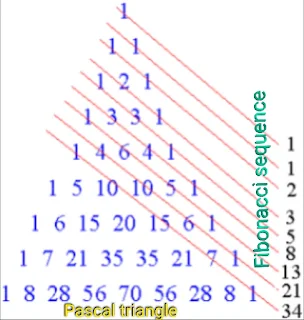Fibonacci sequence
Fibonacci sequence
Fibonacci numbers
Fibonacci sequence history:
1, 1, 2, 3, 5, 8, 13, 21,34 ,55,89...Yes , You are right!
We are going to talk about the Fibonacci sequence, the mystery!!!
We all know that, though Fibonacci ( Leonardo Pisano Bigollo) introduced this sequence first to the western world in 1202; it had been observed by the Indian mathematician as early as the sixth century.
Fibonacci sequence facts:
The most interesting property of this sequence is, the next term/number of the sequence is the sum of the previous two.It doesn't wait to say that this sequence is very important in mathematics. It has a strange correspondence with the Pascal Triangle.It is observed that, the sum of entries in nth diagonal of Pascal's triangle is the nth Fibonacci number (for all positive integer n)!!!
 |
| Fibonacci sequence |
Fibonacci sequence in nature:
There are such a many known-unknown facts about the Fibonacci sequence in mathematics as well as in nature.We all are familiar with the Rabit- Island story. Fibonacci considered the growth of an idealised or biologically unrealistic population of rabbits.He made some assumptions like:
(1): A newly born pair(one male and one female) of rabbit are put in a island.
(2): every pair can mate at the age of one month and can produce a new pair.
(3): The rabbits never dies and mating pair always produces a new pair each month.
Assuming these, Fibonacci observed the growth of the population of rabbits. His query is very simple: how many rabbits will be there after one year?
At the end of first month, the pair mates but there is till only one pair.
At the end of second month the pair produces a new pair. So there is two pairs at the end of second month.
At the end of third month the original pair produces a new pair and the previous newly born pair mates.so there is 3 pair in total at the end of third month.
At the end of forth month the original pair and their first born pair each produces a fresh pair. So there is total 5 pairs at the end of forth month.
In the same process after the end of twelve months or a year a total 233 pair of rabbit are found.
 |
| Fibonacci sequence in nature |
Fibonacci sequence in art:
There are many more natural objects and events which follows the Fibonacci sequence.some of them are : Aloe plant, Buena Mulata pepper, sunflower, snails, falling water,shell fossil, etc. |
So, the Fibonacci sequence is in many places in nature. The intersting fact is it is also found in human body!
Our hands, foot,ear follows the Fibonacci sequence. We have 2 hands with 5 fingers each and our 8 fingers have 3 section (excluding the thumbs). similarly our foot also agrees with Fibonacci sequence.
Fibonacci sequence list:
At last , we wants to highlight one more thing that, often in modern usage the Fibonacci sequence is extended by one more initial term 0.i.e, the extended form of Fibonacci sequence(Fibonacci numbers) is:
0, 1, 1, 2, 3, 5, 8, 13, 21, 34, 55, 89, 144, 233, 377, 610, 987, 1597, 2584, 4181, 6765, 10946, 17711, 28657, 46368, 75025, 121393, 196418, 317811, ...
If you find out any incorrect information or know anything more about this , please write it in the comment section!





Oooh...
ReplyDeleteHelpful👍
ReplyDelete